Gothic art beckons with eight spooky ideas for creative expression. Try haunting Victorian-inspired portraits, macabre still life arrangements with skulls and wilted flowers, or cathedral-inspired mixed media pieces. Shadow play photography captures dramatic contrasts, while mythological creatures come alive in neo-Gothic illustrations. Ornate calligraphy, darkly romantic sculptures, and Gothic Revival textiles round out these dramatic possibilities. These mysterious arts offer a thrilling journey into beauty’s darker side.
Key Takeaways
- Create haunting portraits inspired by Victorian Gothic aesthetics with dramatic shadowing techniques and symbolic elements like skulls and roses.
- Design macabre still life compositions featuring skulls, wilted flowers, and dark fruits using deep reds, purples, and blacks.
- Craft Gothic architecture-inspired mixed media collages with cathedral silhouettes, layered papers, and metallic paint highlights.
- Master shadow play photography techniques using directional lighting, backlighting, and reflective surfaces for mysterious Gothic effects.
- Explore illuminated manuscript creation with pointed pen calligraphy, ornate gold initials, and mythical creature embellishments.
Haunting Portraits With Victorian Gothic Influences
Victorian Gothic portraits capture the eerie beauty of a bygone era, where darkness and elegance collide in haunting ways.
These moody masterpieces showcase subjects dressed in elaborate Gothic fashion, with intricate detailing in lace corsets and billowing fabrics that tell stories without words.
Artists use dramatic light and shadow techniques to create emotional depth, making subjects appear both alluring and slightly unsettling. The dark colors—rich blacks, blood reds, and midnight purples—create an atmosphere that’s both dreamy and nightmarish.
What makes these portraits so enchanting? Perhaps it’s how they combine beauty with mystery!
Gothic art often includes symbolic elements like skulls and roses, reminding viewers of mortality’s constant presence. The ornate frames and backgrounds transport us to another world, one where beauty and darkness dance together forever.
Macabre Still Life Compositions in Dark Color Palettes

Macabre still life compositions offer artists a spooky playground for arranging death-inspired objects like skulls, wilted flowers, and dark fruits against shadowy backgrounds.
These darkly beautiful arrangements often use deep reds, purples, and blacks to create an eerie mood that pulls viewers into contemplating mortality.
Death-Inspired Object Arrangements
When exploring the depths of Gothic art, death-inspired object arrangements offer a haunting glimpse into mortality’s shadowy realm.
Artists carefully select items that speak to the transient nature of life, creating macabre still life compositions that tell stories of our fleeting existence. These dark color arrangements use soft illumination to cast eerie shadows across intricate elements, building a rich visual narrative that’s both beautiful and unsettling.
- Symbolic Objects – Skulls represent the ultimate reminder of mortality, while wilted flowers show beauty’s decay, and unlit candles suggest life extinguished.
- Textural Contrasts – Combining aged wood, tarnished metals, and delicate lace creates depth that draws viewers deeper into the composition.
- Historical Connections – Many arrangements pay homage to Vanitas paintings, where everyday objects carried powerful messages about life’s brevity.
Shadowy Symbolic Elements
The dark heart of Gothic art beats strongest in shadowy symbolic elements that fill macabre still life compositions. Artists carefully select objects like skulls, wilted flowers, and burning candles to tell silent stories about life and death.
Dark hues dominate these arrangements—think deep reds, inky blacks, and forest greens—creating moody scenes that practically whisper secrets.
The magic happens in the contrasting light and shadow, where creators highlight the haunting beauty of everyday objects transformed by darkness. Antique items from Victorian times add an extra layer of spooky history!
The juxtaposition of beauty and decay reflects deeper Gothic themes that make viewers think about mortality—pretty flowers dying next to gleaming skulls tells us something important, doesn’t it?
This artistic conversation about life’s fleeting nature continues to captivate art lovers today.
Gothic Architecture-Inspired Mixed Media Creations
Gothic architecture offers incredible inspiration for hands-on art projects that mix different materials together.
Cathedral silhouette collages use layers of paper, fabric, and found objects to create dramatic skylines with spires and arches that catch the light in mysterious ways.
Suspended buttress mobiles bring the engineering marvels of Gothic cathedrals into three-dimensional space, using wire, wood, and translucent materials to capture the gravity-defying magic that makes these ancient buildings feel like they’re reaching for heaven.
Cathedral Silhouette Collages
Towering spires and dramatic arches come to life through cathedral silhouette collages, a creative technique that captures Gothic architecture’s breathtaking beauty.
This mixed media approach transforms ordinary paper into magical scenes where light dances through stained glass windows, just like in real Gothic cathedrals. Artists layer black cardstock against vibrant tissue paper backgrounds, creating a jaw-dropping dramatic interplay of light and shadow.
Try these awesome Gothic-inspired collage ideas:
- Cut intricate designs from black cardstock and layer over rainbow tissue paper for a stained glass effect
- Add metallic paint to highlight architectural details like flying buttresses and rose windows
- Incorporate textural elements like lace or fabric scraps to represent the ornate stonework of famous cathedrals
Buttress Mobiles Suspended
Inspired by medieval engineering marvels, buttress mobiles transform Gothic cathedral architecture into stunning suspended art. These dynamic creations capture the essence of traditional Gothic elements while floating gracefully in modern settings.
Artists combine wood, metal, and fabric to recreate the intricate elements that once supported massive stone walls, now reimagined as delicate hanging sculptures.
The dramatic flourishes of these mobiles often incorporate dark color palettes that echo the mysterious ambiance of ancient cathedrals. As they gently rotate in space, they cast enchanting shadows that dance across walls and floors!
The architectural features—arches, spires, and flying buttresses—create a sense of movement that breathes new life into Gothic aesthetics. What makes these pieces so special is how they connect us to history while still looking totally cool in the present-day homes and galleries.
Shadow Play Techniques for Dramatic Gothic Photography
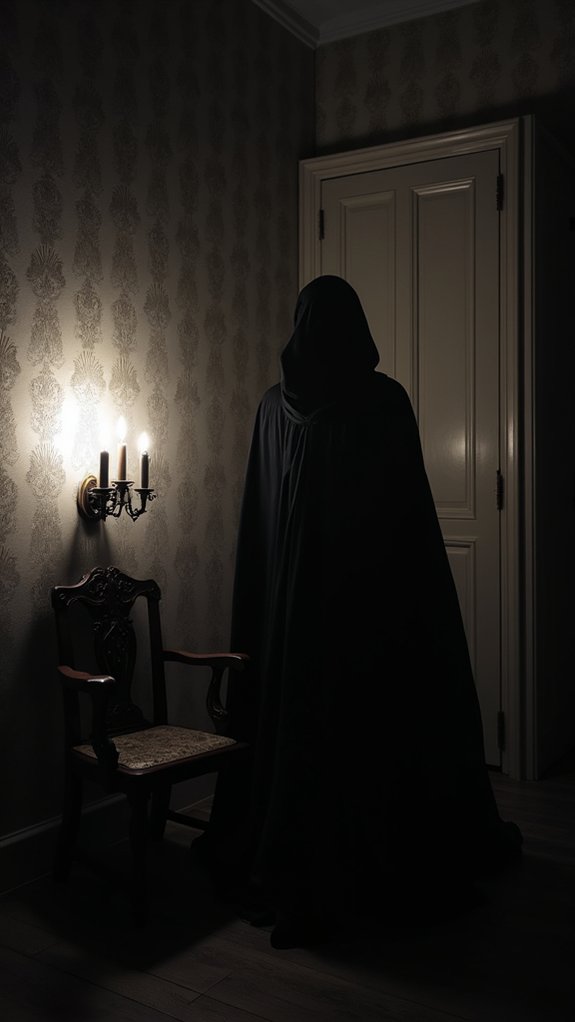
How can shadows transform an ordinary photo into a spine-tingling masterpiece? The clever manipulation of light and darkness creates a moody atmosphere that’s essential to Gothic aesthetics.
Strong directional lighting amplifies dramatic elements, while intricate shadows cast by branches or fabric add texture to the dark aesthetic.
- Position your subject near a window with sheer curtains to create eerie, dappled shadows across their face.
- Try backlighting your subject against a bright background to form mysterious silhouettes that scream “Gothic drama.”
- Experiment with reflective surfaces like broken mirrors or dark water to multiply shadows into unsettling patterns.
Mythological Creatures in Neo-Gothic Illustration
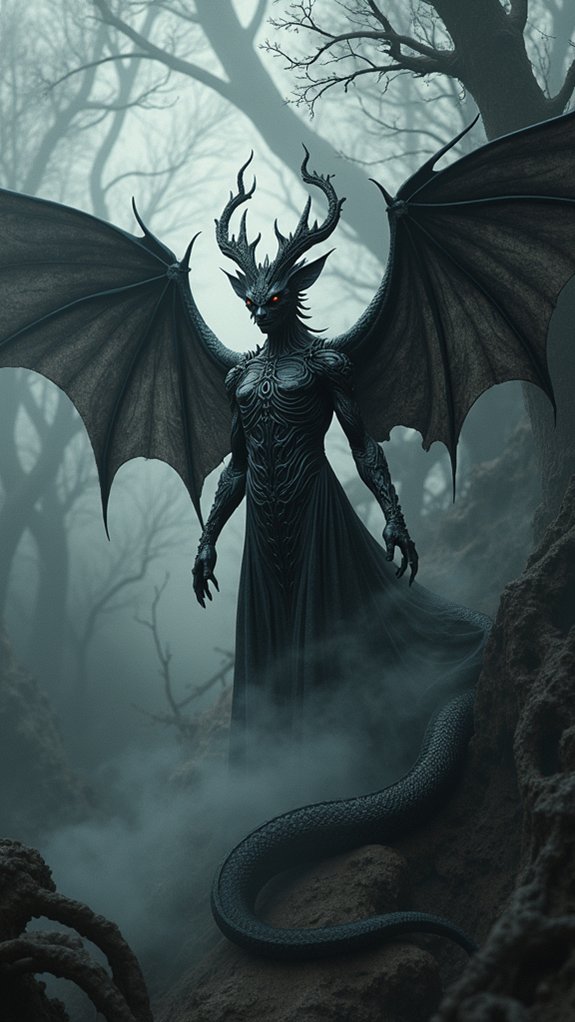
Shadowy creatures from ancient legends lurk in the corners of Neo-Gothic illustration, bringing medieval nightmares to vibrant life.
Artists like Edward Gorey and Anne Stokes have captured these mythological creatures in a darkly whimsical style that middle schoolers find both creepy and cool. Dragons, gargoyles, and banshees emerge from the page through intricate detailing that makes them seem almost real!
Gothic illustration breathes terrifying life into mythical beasts, making the impossible seem frighteningly real through meticulous detail.
What makes these monsters so enthralling is how they play with Gothic aesthetics, using dramatic contrasts between light and shadow. A fairy might appear beautiful at first glance but hide terrible secrets in its shadowy wings.
These supernatural beings often represent both good and evil sides of ourselves, which is why they’re so fascinating. The recent comeback of Gothic art has brought these ancient beasts roaring back into our imaginations—scarier and more detailed than ever!
Ornate Gothic Calligraphy and Illuminated Manuscripts

The mysterious beauty of Gothic calligraphy unfolds across ancient parchment like intricate spiderwebs frozen in time. This artistic craftsmanship emerged in the 12th century, capturing the same dramatic forms found in soaring cathedral architecture.
Monks spent countless hours hunched over manuscripts, using pointed pen nibs to create sharp angles and varying line thickness that gave Gothic script its distinct character.
- Create your own illuminated letter – Design an ornate initial with gold paint and vibrant colors
- Practice basic Gothic letterforms – Master the foundational strokes that give this style its dramatic flair
- Add mythical creatures – Embellish your intricate illustrations with dragons, griffins, or other fantastical beasts
These illuminated manuscripts weren’t just pretty—they represented the preservation of knowledge during the Middle Ages, saving stories and ideas that might otherwise have vanished forever!
Dark Romanticism in Contemporary Gothic Sculptures
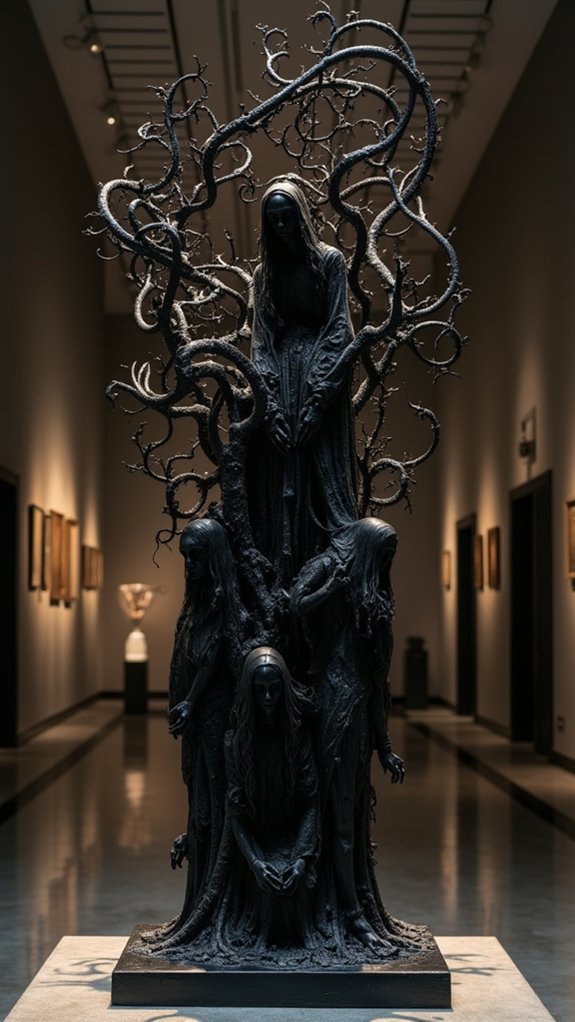
When beauty embraces darkness, contemporary Gothic sculptures breathe new life into centuries-old romantic themes. Artists like Damien Hirst and Kiki Smith create haunting pieces that showcase beauty intertwined with decay, making us feel both drawn to and slightly creeped out by their work.
These intricate sculptures often feature skulls, bones, and ghostly figures carved from marble, bronze, or resin. They’re not just spooky—they’re telling us something important about the duality of existence. Life and death, beauty and horror, they all dance together in these amazing artworks.
The gothic aesthetic is super popular right now! It’s like these artists are taking old-school romantic gloom and making it fresh again, connecting with our own fascination with the darker side of life.
Gothic Revival Textile Art and Tapestries
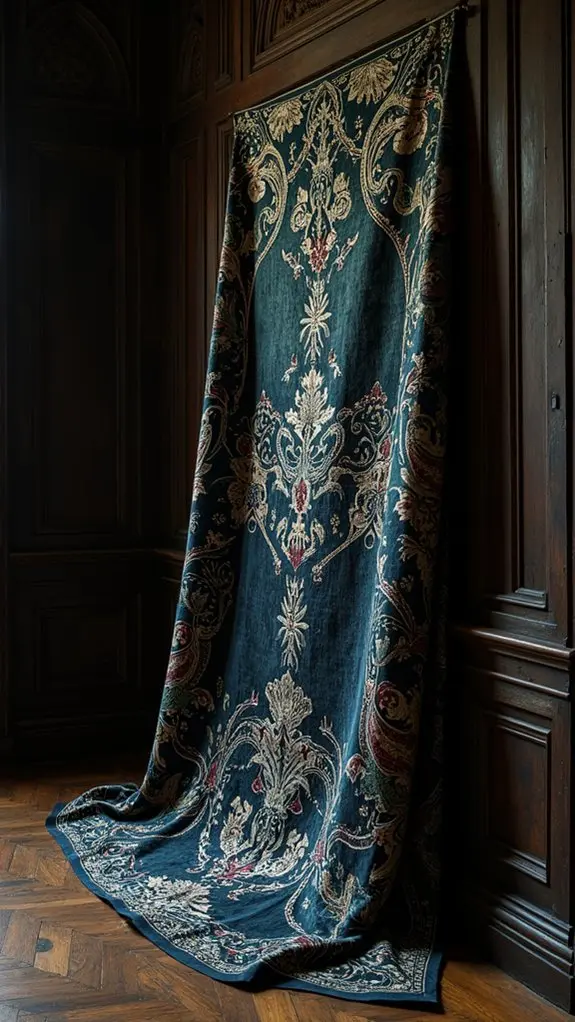
Medieval looms and nimble fingers once brought Gothic Revival textile art to life in the 19th century, creating some of the most breathtaking tapestries you’ll ever see!
The Pre-Raphaelite Brotherhood led this textile revolution, blending historical themes with rich colors that practically leap off the fabric.
These dramatic pieces stand out because of:
Gothic Revival tapestries captivate with their architectural patterns, luxurious materials, and mythological storytelling—a testament to medieval craftsmanship reborn.
- Their intricate designs that mimic the elaborate patterns found in Gothic architecture
- The use of premium materials like wool and silk that create amazing texture and depth
- Storytelling through mythological and religious scenes that transport viewers to another time
Gothic Revival tapestries weren’t just pretty—they were rebellions against mass production!
Today, these masterpieces of craftsmanship add dramatic depth to modern spaces, proving that medieval-inspired art still captures our imagination and adds a touch of mystery to any room.
Frequently Asked Questions
What Are Gothic Aesthetics?
Gothic aesthetics encompass mysterious atmospheres, dark color palettes, and macabre themes. They feature haunting imagery, Gothic symbolism, supernatural elements, and ethereal beauty that evokes both dread and fascination.
What Are the Aesthetics of Gothic Architecture?
Gothic architecture aesthetics feature soaring pointed spires, ribbed vaults, and flying buttresses. Ornate facades showcase Gothic arches framing vibrant stained glass, creating dramatic interplay between dark color palettes and filtered light.
What Are the Themes of Gothic Art?
Gothic art explores medieval symbolism, dark romanticism, and macabre imagery while embracing supernatural elements. Its haunting beauty conveys existential themes with emotional depth through memento mori motifs and religious iconography.
What Is the Aesthetic of Gothic Novels?
Gothic novels embrace morbid romance and psychological horror within dark settings. Supernatural elements permeate narratives featuring tragic heroes amid isolation themes, while eerie symbolism heightens emotional tension and foreboding atmosphere.
Conclusion
Gothic art invites everyone to explore the shadowy side of creativity, where beauty and darkness dance together in perfect harmony. Whether you’re drawn to haunting portraits or creepy creatures, these eight ideas offer a starting point for your own gothic journey. Don’t be afraid to experiment with dark colors, dramatic shadows, and ornate details – the gothic world welcomes all who dare to embrace its mysterious charm.

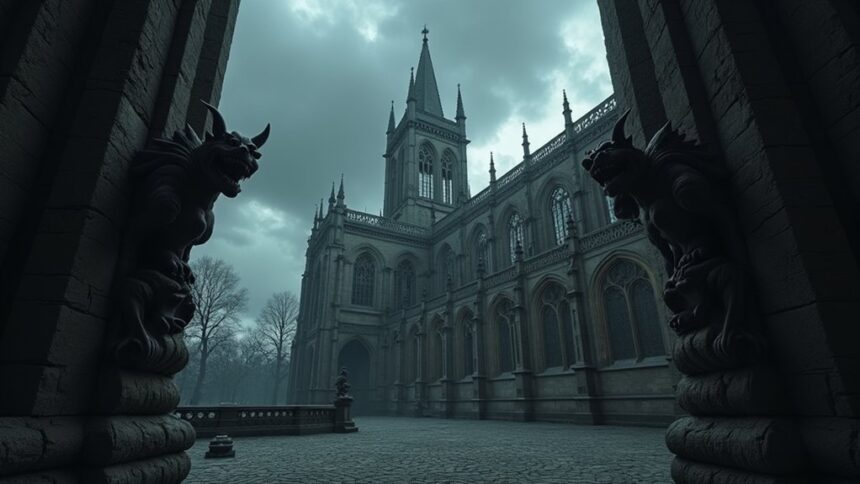
Leave a Reply